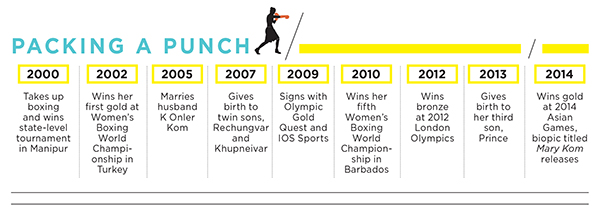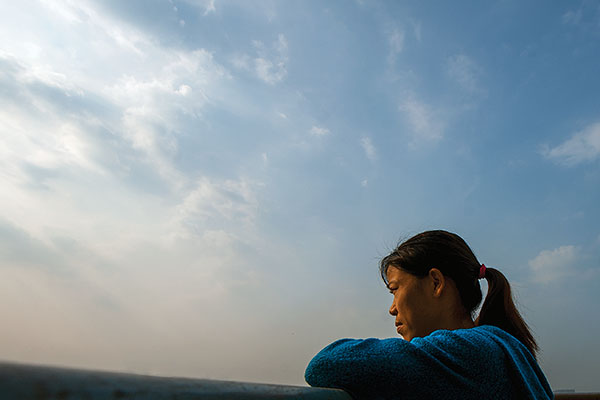
Mary Kom's quiet legacy
Having braved the odds herself, Olympic bronze medallist and five-time world boxing champion Mc mary Kom now wants to help her successors find a smoother path to glory
Mangte chungneijang Mary Kom was 18 when she faced a Thai boxer in her first-ever international tournament. The year was 2001; the venue, the Asian Women’s Boxing Championships in Thailand. “I saw an opponent who was so big. I thought to myself, ‘Wow. What muscles! How can I fight her?’ I was nervous,” says Mary Kom.
In the first round, she was knocked down. By the second round, however, she had regained some confidence. “I remember thinking of my opponent, ‘She’s not that strong’.” Though Mary Kom could not turn the bout around in four rounds, she learnt a valuable lesson. “I lost because I got nervous on seeing my opponent. I said to myself, ‘Next time, I will have a bit more experience’. I got a silver medal in the next World Championship in the US.” Today, the 31-year-old does not get nervous before a fight.
Some athletes need a mental routine to psyche themselves up before a match. Not Mary Kom. According to Viren Rasquinha, CEO of Mumbai-based Olympic Gold Quest (OGQ), an organisation that trains sports stars, the boxer is very intense and quiet on the day of a bout. “If you tell Mary she has to talk in public, she gets nervous. But I’ve never seen her nervous or scared of anyone when she has to fight. That’s her comfort zone,” says Rasquinha, former captain of India’s national field hockey team. “When she puts on the boxing gloves, she has only confidence. She rules the ring. If you see her walking out, she has the swagger.”
There’s no hint of that swagger when Forbes India met her for breakfast at Mumbai’s Palladium Hotel. Mary Kom had her plate piled high with sausages, bacon, grilled vegetables and roasted potatoes. She also likes beef jerky and dried fish, but Manipuri rice is an absolute must. When she’s travelling for tournaments, she even carries a rice cooker with her.
The breakfast lounge slowly fills up with businessmen from all over the world. But Mary Kom has been to a country few have had the opportunity to visit. “I was in North Korea in 2003,” she says. Her corporate sponsors clarify in unison, “You mean South Korea, right?”
“No,” she says.
In 2004, when she was 21, Mary Kom travelled to Pyongyang for a training camp. “We really suffered on the tour of North Korea because they didn’t give us any food. Only French fries and some bread. We had to pay for everything and, even then, we got very little. The North Koreans were not polite. I could tell from their faces. It’s a very strict country,” she says.
With 16 endorsement deals, 19 medals in international tournaments and a Rs 100-crore Bollywood biopic, Mary Kom has come a long way from low-budget tours in North Korea. She’s a four-time Asian Women’s Boxing Champion and has won five consecutive gold medals in the Women’s World Amateur Boxing Championships, but she caught the attention of cricket crazy-India only in 2012, when she won a bronze at the London Olympics. Today, she is a celebrity, feted across the country, but it doesn’t show in her demeanour.
She’s quiet and reserved at first, but half-an-hour into the interview, she reveals a cheerful disposition. “When I started boxing, people said I was mad. I think about boxing not only during practice, but also at home when I cook and even in the market. It’s my passion,” she says, raising her fists.
Her life story—how a daughter from a poor tribal family in Kangathei in the Churachandpur district of Manipur became India’s most famous boxer—is well known. After all, actress Priyanka Chopra’s portrayal of Mary Kom in Omung Kumar’s eponymous film made sure of that. In a tale that’s all too common in Indian sports (barring cricket), the boxer achieved acclaim despite the sub-standard training facilities, paucity of good coaches and lack of media attention.

Women’s empowerment, better sporting infrastructure and drawing attention to the neglected Northeastern states of India are issues close to her heart.
“There is no good training facility in India, especially in Manipur. It’s still the same as when I started out 10 to 15 years ago,” she says.
Mary Kom has already upgraded her boxing academy, Mary Kom Regional Boxing Foundation, in Imphal. She founded the academy in 2006, but only last year received Rs 3.6 crore from the National Sports Development Fund to improve the facility. She’s also been given three acres of land from the Manipur government to build a gymnasium, buy equipment and create outdoor boxing facilities.
“We’re trying to raise money for a hostel,” says her husband K Onler Kom, who manages the academy. “Around 35 boxers still live in rented accommodation. I hope the hostel will be ready next year,” he adds.
The boxing academy divides students into three categories: Beginners, national-level players, and those with the skill to compete in international tournaments. For this, she needs at least six coaches. The Sports Authority of India has sent a coach from Maharashtra, she says, but the reality is that she cannot rely on government funding alone.
Part of the problem, says Mary Kom, is that many coaches are only national-level athletes. “I don’t want national-level boxers training international talent. We have so many Olympians and Asian/Commonwealth Games champions who want to help boxing after retirement. My idea is to attract them to coach and run the academy,” says Mary Kom.
Prabhu Srinivasan, CEO and co-founder of Mumbai-based sports education startup KOOH Sports, says “The challenge is that politicians who have very little interest in what happens to sport are running sporting organisations.” (Nonetheless, KOOH Sports has partnered with several government agencies and continues to receive their support.)
India’s sports infrastructure, even regarding talent-spotting, is not developed. In the US, a strong high school and collegiate sports system identifies and nurtures talent. In Europe, well-funded professional sports clubs take on this job. In India, sports stars often have to rely on corporate sponsors such as Edelweiss Financial Services Ltd, which has been funding Mary Kom since 2009 through OGQ.
Since 2010, Edelweiss has donated over Rs 1 crore to Mary Kom through OGQ.“Edelweiss approached us in 2009 when I had just started working with OGQ,” says Rasquinha. The Edelweiss funding provided Mary Kom with a world-class coach (Charles Atkinson), a female personal physiotherapist and a host of medical and nutritional supplements. Under Atkinson, training sessions have become shorter, structured and intense, leaving more time for rest and recovery.
Founded by Indian sporting legends Geet Sethi (billiards champion) and Prakash Padukone (the former badminton player), OGQ has nurtured the likes of Saina Nehwal, Gagan Narang and Vijay Kumar.
Mary Kom, too, has evolved into a mentor and coach, and that comes naturally to her, says Rasquinha. “You should see her sparring with the kids. Only a good eye can spot deficiency in technique.”
Her commitment to helping others has won her the admiration of peers and professionals. Mustafa Ghose, CEO of JSW Sports (the Mumbai-based sports arm of the $11 billion conglomerate, JSW Group), says, “She’s been a breakthrough performer for India at every level. Mary Kom has had first-hand experience of overcoming hurdles.”
Mary Kom also wants to provide young boxers at her academy with basic education—at least up till class X. She knows that her lack of education means she cannot communicate as well as she’d like to in Hindi or English. “I find it very hard to express myself,” she says.
That said, Mary Kom does not let her limitations define her. “I am fully confident that I can speak whatever is in my heart.”
And sport is nothing if not all about the heart.
(This story appears in the 26 December, 2014 issue of Forbes India. To visit our Archives, click here.)
-
 Usha Subramaniam
Usha SubramaniamInspiring indeed. But there is no new information in the story. What are Mary\'s dreams for aspiring women boxers of the country? What improvements would she like to see in sports administration in the country? Does she feel optimism & hope for future sports girls & women?would she do something, given the chance?
on Dec 19, 2014















